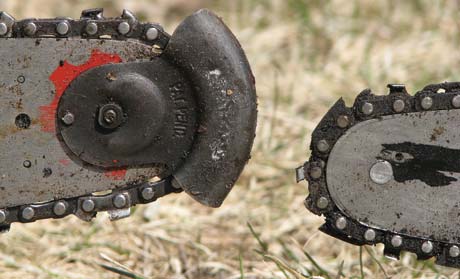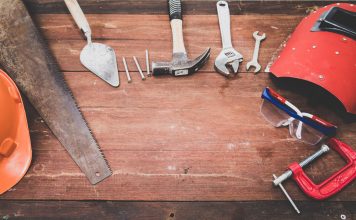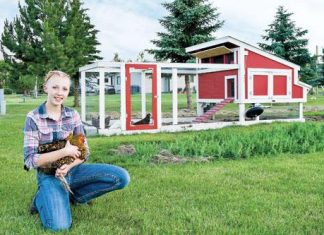| Issue #119 •September/October, 2009 |
Winter will be here soon and along with winter comes cold weather and high heating bills. Obviously there’s nothing new about any of this but with the current economic situation a lot of people are going to be cutting their own firewood for the first time and they’ll be purchasing a chain saw to do it.
The first chain saw I ever owned was an old, very used Craftsman with an 18-inch bar. It was given to me by my grandfather. It had a cast iron motor and weighed at least 20 pounds. It had no chain brake, no vibration dampeners, no muffler or spark arrestor, and a manually operated pump to oil the chain. It did a great job cutting firewood but it was heavy and dangerous.
|
Chain saws have come a long way in the last 40 years. Modern saws are lighter, safer, and easier to use than those in the past. There are more choices and options than ever before, and while that’s good it can also get a little confusing. So, how do you choose the best chain saw for you? You look over the options then pick the saw that will best serve your needs.
Bigger is better…right?
Don’t buy a chain saw based on bar length and power alone. I believe in purchasing the biggest saw you can safely control but don’t buy a big saw just to stroke your ego.
The saw I use most is a Stihl with a 24-inch bar. The extra power and bar length make quick work of large trees and limbs. But big saws have their disadvantages also. The handles are usually larger and spaced farther apart. The longer bar adds extra weight to the front and makes the saw harder to control when cutting. Professional quality saws also use more aggressive chains that cut faster but make them more susceptible to kickback. Plus, they’re expensive.
Small saws have some very real advantages. They cost less than professional saws and they’re much lighter than full size models designed for either professional or home use.
One thing most of us men fail to consider is what will happen if we are injured and can’t cut wood. Will our wife or older children be able to cut it while we recover? This is a serious matter if you heat only with wood and can’t afford to buy it from a vendor.
My wife’s saw is a Homelite with a 16-inch bar. She loves it. It’s light, fits her well, and she can control it. I used a McCullough Mini-Mac with a 14-inch bar for more than 10 years. I’ve cut more than 100 cords of wood with it and it’s still working great. Small saws are quite capable of cutting a year’s supply of firewood. They just take longer.
Reliability
As long as you stay with a major brand, reliability is not usually a problem. I’ve owned saws made by Poulan, Homelite, McCullough, and Stihl. While it’s true that you get what you pay for, even lower priced saws tend to last a long time with careful use and maintenance. Professional saws are built with better materials and engineering, but the difference is not usually going to be a factor for the homeowner cutting his own firewood.
Regular maintenance goes a long way to keep your saw fit for duty. Clean or replace the air filter often. Replace the spark plug annually or according to manufacturer’s recommendations. Use a high quality two cycle oil for the gasoline mixture, and a good bar and chain oil to get the longest life out of your bar and chain. Lube the roller sprocket often.
|
Fit
A chain saw should fit you. What I mean by fit is that it should be comfortable to hold and work with. Try different saws and you’ll see what I mean.
Handle sizes and the spacing between the rear and front handles may vary significantly. Lean over in a position similar to how you’ll stand when cutting wood. Does the saw balance well or is too much of the weight forward? How does the saw feel with the bar in both vertical and horizontal positions? How about with it held high as when cutting overhead limbs? Is your forward hand too far forward or too far back? Can you reach the trigger easily?
You’re going to be using this thing for hours. Heft a lot of different saws so that you can tell the difference between a good and bad fit.
Control
This is a mindless machine with dozens of razor sharp teeth racing around a long steel bar within inches of your hands, feet, legs, and sometimes, face. It doesn’t care whether it’s cutting through downed trees or flesh and bone. Can you control it?
It’s vital that the saw fit you. Put on some leather work gloves. Do your fingers wrap around the handles completely? Can you use the throttle trigger while maintaining a good grip? Can you shut it off without taking your hand off the handle? When the saw slices all the way through the limb can you keep the tip from falling to the ground?
Is the saw too heavy or the balance point so far forward that when you begin your cut you drop the saw on the limb because you don’t have the strength to hold it up? Is fatigue going to be a problem? Can you hold the saw with the motor in front of your body, or is it so heavy or are the handles so far apart you must hold the motor next to your side when cutting?
Is the chain too aggressive or the saw so powerful that you’re afraid of it? Should you start with a smaller saw until you gain more experience?
Safety features
While any chain saw is inherently dangerous, modern saws are much safer than they were 40 years ago. The first saw I ever used had no chain brake, no handle vibration dampers (not even rubber cushions on the handles!), and a chain and bar design that screamed out the words “kickback.” Thank God those days are long gone.
Chain brake
Saws with chain brakes have a bar in front of the forward handle so that if kickback occurs your hand will strike the safety bar which applies a brake that instantly stops the chain from spinning. It’s the greatest improvement ever made to a chain saw.
|
Kickback occurs when the upper front part of the chain comes in contact with the wood you are cutting. Because the chain is moving in a circular direction as it revolves around the end of the bar, it acts like a spinning wheel (with sharp claws) to launch the front of the bar upward and back if it makes contact with the wood you are cutting.
This might happen if you are cutting up through a limb and the tip of the bar contacts the wood as you begin your cut or it can happen if you are cutting down through a limb that’s supported on both ends and the limb bends and pinches the upper front part of the chain in the kerf.
In either case the front of the bar will be launched upward and back with considerable force and velocity. In severe cases it can dislocate your thumb on the hand that’s holding the front bar. I’ve had chains rip the skin off my thumb and once nearly lost an eye and ear from kickback.
To prevent kickback, do not let the tip of the bar and chain contact the wood you are cutting. Keep the wood centered on the bar and don’t try to cut trees or limbs that are too large for your saw.
Note: Some saws without chain brakes have a safety bar in front of the handle. Its purpose is to deflect the saw should kickback occur. While this is helpful, it is not a chain brake. It does nothing to stop the chain.
Chain and bar designs
Chain and bar designs improve the performance of your saw and can reduce the chances of kickback. Homelite probably has the most effective anti-kickback feature on the market. They call it the “Safe-T-Tip” and it’s a shield placed over the end of the bar so that the chain cannot make contact with anything as it screams around the end of the bar. It does make the bar slightly heavier, and limits the size of wood you’ll be able to cut, but the trade-off is virtually no risk of kickback.
Chain designs can also affect kickback. One style has raised links between the cutting links on the chain. These often have a “tail” on the back end of the link that rise when the chain goes around the tip of the bar and push the cutting edge away from the wood. It’s not as fail-safe as the Homelite method, but it does help.
The “skip-chain” is a fairly recent innovation in chain design. It doesn’t prevent kickback but it does improve performance on some saws. It’s used on saws that are slightly underpowered for the bar length and is found most often on mini-saws or on larger saws with extended bars.
A skip-chain has fewer cutting links than a “regular” chain. An aggressive chain, like those used on professional saws, have a cutting link on every other link of the chain. A skip chain has a cutting link on every third link.
The skip-chain is less likely to bog down the saw when cutting larger pieces of wood because there aren’t as many cutting links in contact as there would be with a regular chain. Because it has less drag, the motor of the saw runs at a higher RPM. This gives the chain more speed so it cuts faster.
It’s like going uphill in a big car with a small engine. As you go uphill the motor slows down and loses power. When the car downshifts, the motor speeds up and the car also speeds up because your engine is in a more efficient power curve. A skip chain keeps your chain saw running in its most efficient power curve for faster cutting.
Large professional saws usually do not have skip-chains. They have enough muscle to power their way through any tree with ease.
The “depth gauges” (sometimes referred to as “depth stops”) on a chain are the vertical metal tabs found just in front of the cutting tooth. Some people file these down to give the chain more “bite.” If they are filed down too far, the chain grabs and jerks the saw as you cut. It also makes kickback more likely. If the depth stops are too high the chain won’t cut well. There are gauges available for filing down the depth gauges. Get one and use it. I usually file them about every third time I sharpen the chain.
|
Vibration dampers
Early saws had steel handles bolted directly to the motor. After a few hour’s use your hands often became numb from the vibration and frozen from the cold if it was wintertime. Then someone got the idea of putting rubber grips or padding on the steel handles. It helped a little on both the cold and vibration problems. Finally, somebody thought of attaching the handles with springs or rubber insulators to help dampen vibration from the motor and chain. To that final somebody, I’d like to say thanks.
Vibration dampening is the second greatest innovation on modern saws after chain brakes. Vibration dampers not only make chain saws more comfortable to use, they make them safer as well.
It’s really difficult to keep control of a chain saw when your hands are numb from vibration. But vibration control is more than a safety issue. You’ll be able to spend more time cutting if your saw is comfortable to use.
Oil pumps
I only mention manual pumps for chain oiling here in case you run into an older saw and plan on buying it. I haven’t seen a manual chain oil pump in years and I don’t miss them. They work well when used, but it was not unusual back then to see a lot of bars with blue sections on the edges from overheated chains.
|
Saws today have automatic oilers and most function quite well. Some of the better saws have ways to adjust them, but all of them I’ve used worked well just as they came from the factory. If it isn’t working, take it in to be repaired. There’s probably dirt plugging an orifice somewhere.
The way I check the automatic chain oiler is to point the tip of the bar at the tree or log I’m cutting (keep the chain two or three inches away), and race the engine a couple of times. You should see a “line” of oil spray from the chain on the log.
Use commercial bar oil, not used motor oil. Bar oil comes in different weights for winter or summer use. Follow the manufacturer’s recommended oil weight (viscosity) for your saw.
Price
Ahh, the bottom line for most of us! In the past year I’ve seen new gas powered chain saws on sale for $89.99. (I paid $59 for my little McCullough Mini-Mac.) I gave almost $400 for my Stihl, and would have spent even more if I’d had the money to spare. But regardless of the price, most chain saws will last for years with proper care and maintenance.
Now, if you have lots of money, there are some very high quality (and expensive) saws in small sizes. But if you plan on buying a bigger saw later and just keep the small one for a spare, then you might want to start with a lower priced saw.
Whatever saw you decide on, make sure that the saw fits you well, with a power/size range that you’re comfortable with, and that you can operate safely. Then go cut some wood.





















I do alot of work with saws, from rebuilding to parting out. Each company has good points and bad. One main thing to consider on saws if you do not work them yourself. Is good servicing dealer close by. If no one is close, educate yourself on maintaining and repairing your own.
As to skip chain, it’s been around a long time. Its main function is proper chip clearing on long bars. It will also help with under powered saws with longer bars then manufacturer suggested
Thanks for mentioning that chainsaws that have chain brakes prevent accidents from occurring if there is a lot of kickback once the chain encounters the wood. My husband and I recently moved into a home that has a woodburning stove, and we’re wanting to build a good-sized woodpile before winter comes. We’ll have to start looking for great deals on chainsaws in our area!
I can’t agree with you less.
Been running saws > 45 years now.
You mention “safety features” , and mention “skip chain”. No newbie should think about skip chain until they have a 100+ cc saw.
For inexperienced, the “safety” features are good, but they suck in the cut/use.
Pro saws ARE both lighter AND more powerful than homeowner saws, but they cost more.
I have old Homies, and 15-20 Stihls, none are “homeowner saws”, and I fix them myself